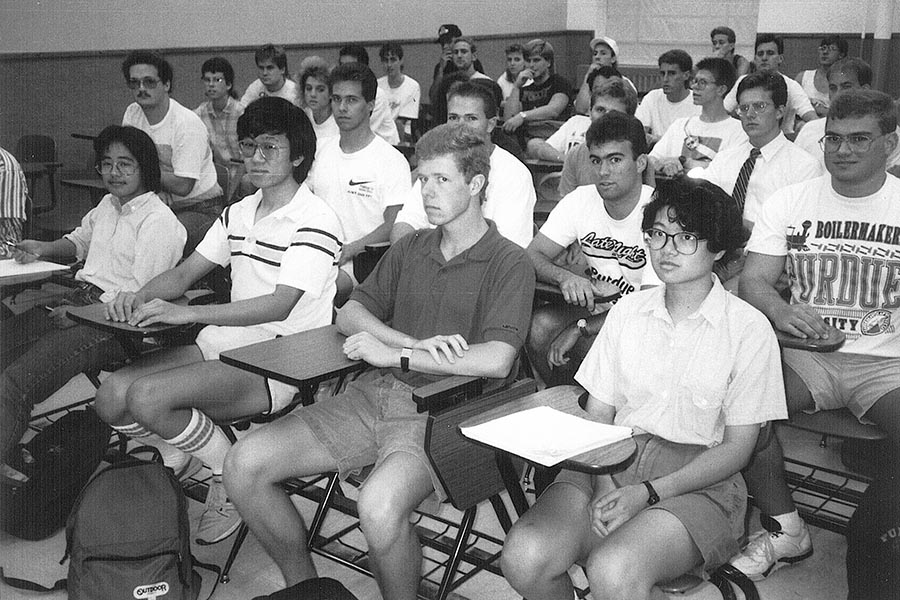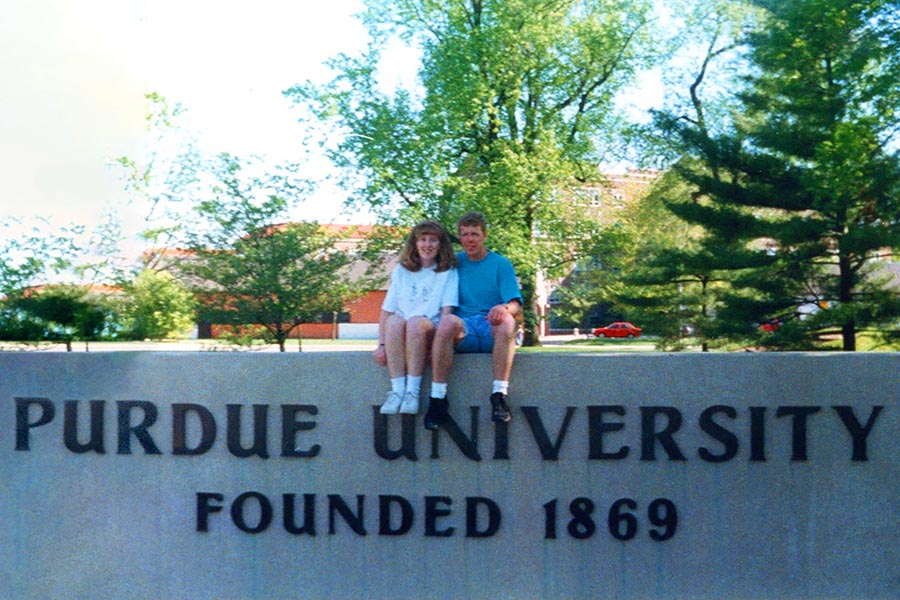My parents met in Prof. Krousgrill's class 30 years ago!
Sesquicentennial professor
“I’ve been teaching at Purdue since 1980,” says Prof. Krousgrill, professor of mechanical engineering. “And I was a student here for ten years before that. So that’s 50 years at Purdue, and Purdue is only 150 years old. So if you randomly pick any year of Purdue’s existence, there’s a one-in-three chance I was here!” (This may or may not have had something to do with Prof. Krousgrill being named Purdue’s 150th Anniversary Professor in 2018).
Teaching all those decades of classes, Prof. Krousgrill admits that keeping up with thousands of student names has always been a challenge. “Traditionally, the first day of class I would take a picture of where the students were sitting,” he says, “and then ask them to sit in the same seats through the semester. That has helped me remember thousands of names, but it’s also produced an amazing pictorial history of all the students I’ve ever taught.”
Sure enough, a few mouse clicks later, Prof. Krousgrill pulls up the class photo of Machine Design from the summer of 1992, pointing to Matt Lothamer and Anne McLaughlin.

Matt Lothamer (center), looking thrilled to be in Machine Design summer class
Summer love
“My brothers had gone to Purdue, but honestly, I didn’t know what I wanted to do with my life,” remembers Anne. “I started out in science, and went to biochemistry. But then I met someone who did orthopedics – artificial knees and hips – and that really interested me. They said mechanical engineering was the way to go. So I switched over in my sophomore year.”
Anne pursued a co-op, a Purdue Engineering program allowing students to alternate semesters between studying in the classroom, and working in industry. Anne worked at Depuy, an orthopedics company in Warsaw, Indiana. But this meant she needed to catch up if she wanted to graduate on time. So she decided to take one of her classes, Machine Design, during the summer.
“Machine Design I is really one of the best courses we teach,” said Krousgrill. “It builds on the students’ fundamental work in dynamics, and then applies it to real-world machines. In the summer, we met in class five days a week, and then a couple days a week they had a recitation where they would gather and work on their designs.”
Because co-op students often took classes during the summer, many came to know each other pretty well – sometimes in odd ways. “The grad student running the recitation made us do this icebreaker game,” remembers Anne. “Everyone stood in a circle, and we had to say our first and last names, and then also the first and last names of all the people in the circle before us. So we’d bump into each other in the hallway and make a joke about it: ‘Hey, Anne McLaughlin!’ ‘Hey, Matt Lothamer!’”
Matt Lothamer had also been doing a co-op, at GE in Fort Wayne. “I was always interested in the way things worked,” said Matt. “If you want to be an engineer in the state of Indiana, Purdue is the place to go. I didn’t apply anywhere else.”
Matt ended up sitting next to Anne during one of their first projects. “They told us we could use any computer language to solve this problem,” remembers Anne. “We had both learned FORTRAN, but Matt said, ‘Why don’t we just use Excel?’ I had never used Excel, so I asked him to teach me. We were done in a few hours, while everyone else was still struggling through it! So that’s when we started doing our projects together.”
Working on those summer projects helped them grow together quickly. “Because everything’s compressed, those summer classes are pretty intense,” says Anne. “We spent many long hours together in the computer lab.”
“She was so smart and so friendly,” remembers Matt, “and she knew how to handle herself with a bunch of guys!”
The couple worked on other projects too, including one with Pi Tau Sigma, the Mechanical Engineering Honor Society. “The Engineering Fountain had just been built,” says Matt. “So we organized a design competition where students attempted to harness the power of the fountain to shoot a projectile with a catapult. Of course, you can’t do that now, because they put a huge metal cylinder in the middle of it!”

Dr. Anne
Both Anne and Matt graduated from Purdue in 1994. Matt entered a management program at GE which sent him to South Carolina, but Anne was inspired to take a different path. “Through my co-op experience, I became really interested in medicine,” she says. “We would watch surgeries for these artificial knee and hip replacements. I wondered what it would take for me to be that surgeon.”
Anne pondered applying to medical schools, but knew she needed something that would make her stand out from the others. “I went to Professor Krousgrill for help,” says Anne. “We came up with this idea of measuring the chaos of a heartbeat, and the plot itself actually looked like the shape of a heart. I took those plots with me on my interviews, and that really helped me explain to med schools how my engineering background would be useful.”
She enrolled at Dartmouth’s Geisel School of Medicine in New Hampshire, and found she had to embrace a new kind of learning. “There’s a lot of rote memorization in med school, as opposed to the problem-solving process we learned at Purdue,” says Anne. “But when it came to analyzing things like how the heart pumps, I completely understood it, because I had already done my work in fluid dynamics!”
As Anne forged ahead in medical school, Matt got a job with GE aircraft engines in New Hampshire to stay close. He continued to follow Anne as she finished her residency at Duke; and then a fellowship at University of Virginia; and finally, a Deaconess Health System clinic in Newburgh, Indiana, outside of Evansville. “At that point, we had little kids,” says Matt, “So I decided to become a stay-at-home dad, which I’ve been ever since.”

The next generation
Emily, the oldest of the three Lothamer children, is now a sophomore at the Weldon School of Biomedical Engineering. Like her mother, her choice to go into engineering wasn’t immediately obvious. “When I was growing up, I wanted to be dog trainer, and then I wanted to be an architect,” says Emily. “My high school teachers told me that I should be doing engineering, and obviously both my parents were engineers. But as my mom will tell you, I just don’t do things the easy way!”
Microsoft Excel once again came to the family’s rescue. “I made a spreadsheet!” laughs Anne. “I showed Emily all these schools – how much they cost, and their reputations. Purdue just made sense.”
Any doubts Emily had about her parent’s alma mater disappeared as soon as she arrived. In addition to engineering, Emily is also a double major in genetics, and plans to conduct research at Prof. Luis Solorio’s biomedical research lab. “Purdue has really become home,” she says. “I’ve loved every moment of being here. This is where I need to be.”
As part of the biomedical engineering curriculum, Emily had to take a class in Basic Mechanics. “I was a little concerned, because this is my only ME class, and my parents have told me so many horror stories,” says Emily. “When the schedules came up, I told my mom I had Professor Krousgrill, and she turned her head and said, ‘You have who?!’”
Remembering their own experiences, both Anne and Matt encouraged Emily to take the class with Prof. Krousgrill. “When he teaches something, it just makes sense,” says Matt. “It’s very logical. He writes it on the screen, and it just clicks.”
Anne also remembers, “With some of my other classes, I would walk out of the room and say, ‘I have no idea what they were talking about.’ But that never happened in Professor Krousgrill’s classes. I never had to figure it out later; I understood it right then and there.”
Even in the COVID era, Emily gives Prof. Krousgrill glowing reviews. “This is by far the most organized online class that I’ve had,” she says. “He has it all on the screen, I can see what he’s writing, and how I should work problems out. When I do the example problems, I don’t have to go back to the book; I just know how to do it. Ten out of ten!”
As for Prof. Krousgrill, he takes his generational influence with trademark humility, while also noting: “The frequency of this increasing. This semester, I have five students whose parents I have also taught!”
As a physician, Anne has seen her Purdue experience come up in unusual ways. “I use engineering principles all the time,” says Anne. “I drive people crazy in my office, because I do things so systematically. We’ve run efficiency studies, so we can see how our patient visits should be structured.”
She continues, “Purdue has a lot of prestige, which really opened doors for me in my career. But beyond that, it was more rigorous than any training I’ve ever done. If you can get through Purdue ME, you can get through anything.”
Emily also acknowledges the role Purdue played in the values her parents passed down to her. “My dad is one of the most honest and hard-working people I’ve ever met in my life,” says Emily. “And my mom has shown so much perseverance in her journey. It’s really inspired me that I can have a successful career as a woman in engineering, and be a strong and independent person. I admire my parents so much, and their meeting at Purdue is a big part of that.”
Writer: Jared Pike, jaredpike@purdue.edu, 765-496-0374
